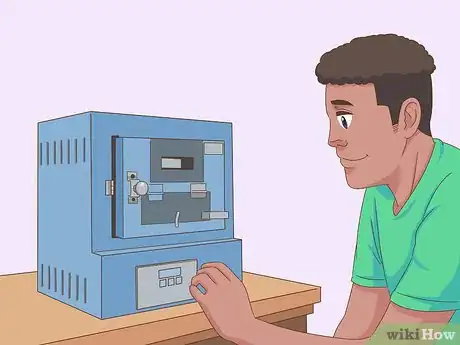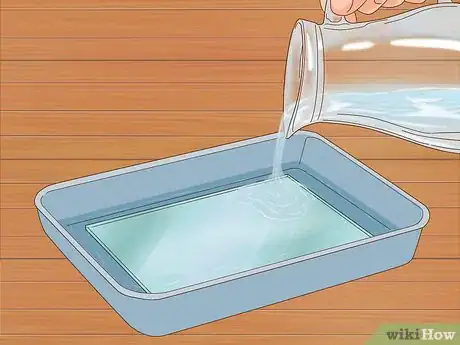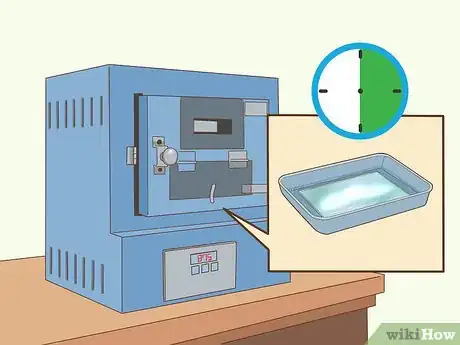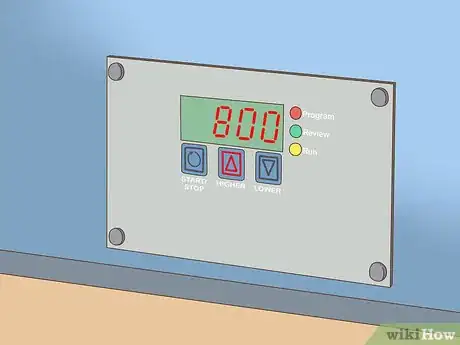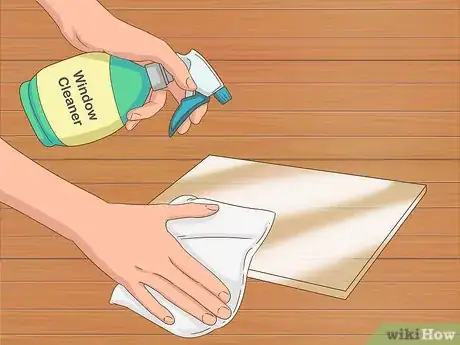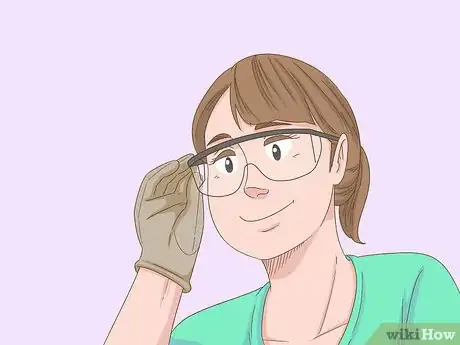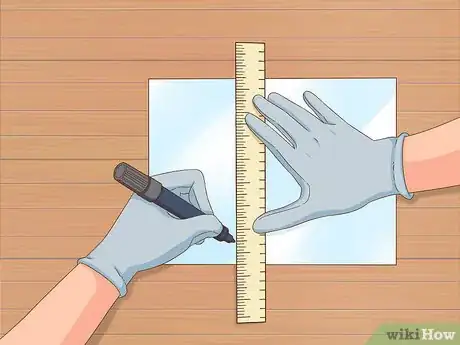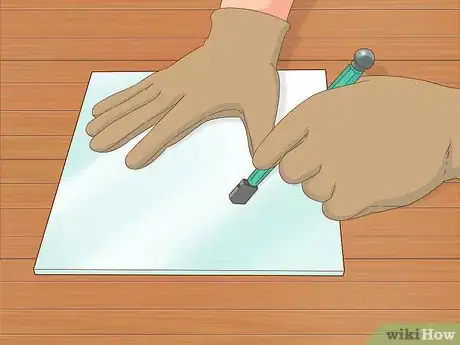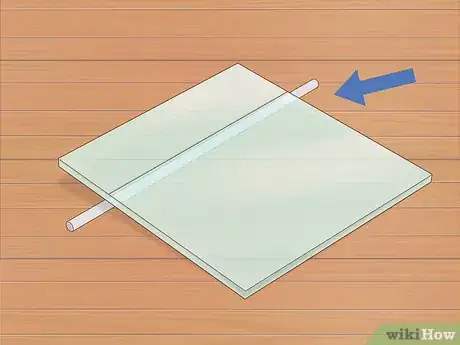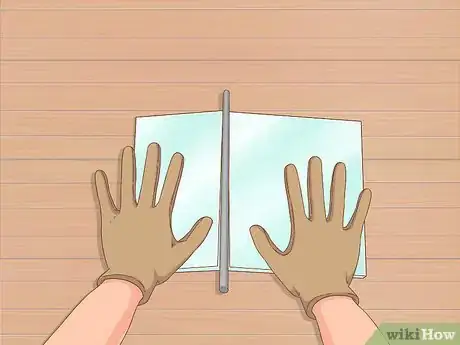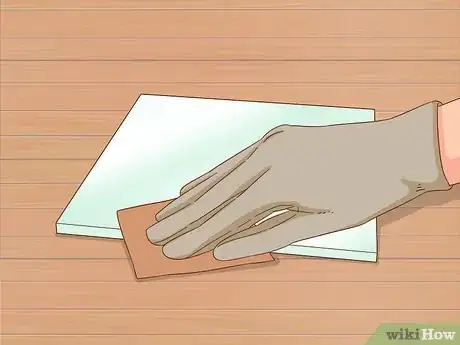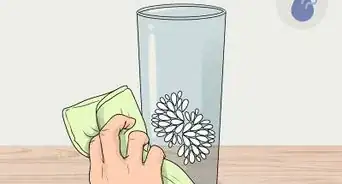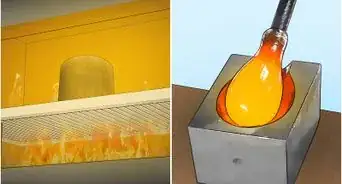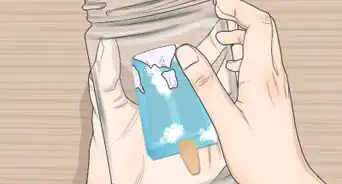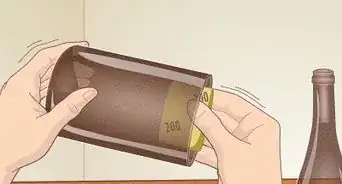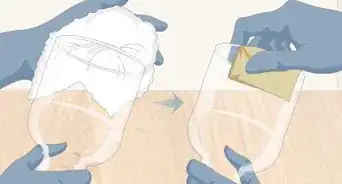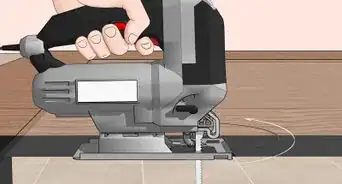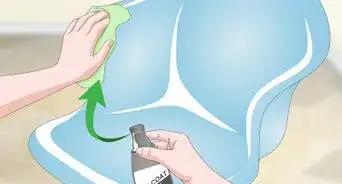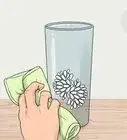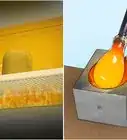This article was co-authored by wikiHow Staff. Our trained team of editors and researchers validate articles for accuracy and comprehensiveness. wikiHow's Content Management Team carefully monitors the work from our editorial staff to ensure that each article is backed by trusted research and meets our high quality standards.
wikiHow marks an article as reader-approved once it receives enough positive feedback. In this case, several readers have written to tell us that this article was helpful to them, earning it our reader-approved status.
This article has been viewed 441,579 times.
Learn more...
Because it’s a type of safety glass, tempered glass cannot be cut using the same methods as you’d use to cut ordinary, untempered glass. If you must cut through a pane of tempered glass, you’ll need to heat it to nearly 1,000 °F (538 °C), then slowly cool it. This process is called annealing, and it will effectively undo the tempering process, weakening the glass to the point that you can cut it. Once it’s cooled, the glass will be in a state in which it can be cut. Anneal the glass if you have access to a kiln. Otherwise, you'll need to take the glass to a professional glass cutter. Also visit a professional if you need to cut a piece of glass larger than about 10 inches (25 cm) across.
Steps
Annealing the Tempered Glass
-
1Gain access to a kiln that you can use to anneal the glass. The intense heat of a kiln is required to soften the tempered glass's coating and begin the annealing process. Kilns are most commonly housed in rooms used for art classes. You may be able to access a kiln through a community college art program.
- The annealing process will uniformly heat up the tempered glass so that all the stresses from the tempering process will be removed. These stress points are the reason that tempered glass shatters into countless small pieces when cut.
- Without these stress points, annealed glass can be cut without shattering.
-
2Place the tempered glass in a heat-proof vessel and cover it with water. Then cover the glass with enough warm water to fully cover the sheet of glass. Unless you're working with an unusually thick section of glass, 3⁄4 in (1.9 cm) of water should suffice.
- If you don't have a flat, heat-proof vessel, ask the art studio manager if they have one you can use. If you're not in an art studio, speak to whoever oversees or owns the kiln you're using.
- You can also purchase such a vessel at an art store or a glass store.
Advertisement -
3Soak the tempered glass in the kiln for 30 minutes. The glass needs to reach a high enough temperature in order for the tempering to be undone. So, turn the kiln to at least 875 °F (468 °C) and soak the glass until it reaches the temperature at which it will anneal. The heating time will vary based on the size of the glass you are annealing, but most types of glass will take about 30 minutes in the kiln. After this time has passed, the sheet of glass will have reached a uniform temperature.
- Soak Effetre (Moretti), Bullseye, and Lauscha glasses at 940 °F (504 °C). Soak Borosilicate glass at 1,050 °F (566 °C). Satake tempered glass is best soaked at 890 °F (477 °C). Use the built-in temperature controller to keep the temperature inside the kiln constant.
- Soak glass beads smaller than 1 inch (2.5 cm) for 20 minutes to anneal them. This will undo the tempering. If you want to anneal beads larger than this, soak them for 8 hours.[1]
- If you're annealing a large paperweight, soak it for up to 12 hours. Very large pieces of glass weighing 100 pounds (45 kg) or more can take months to anneal.
-
4Cool the glass slowly until it is below its strain point temperature. If you don’t know the type of glass you’re working with, lower the temperature of the kiln to 800 °F (427 °C). A cooling temperature of 750 °F (399 °C) works well for for Satake glass. Cool the tempered glass in the kiln for 2-3 hours.[2]
- Cooling the glass too quickly will cause additional stresses to develop and weaken the annealed glass.
- The strain point is the temperature at which the internal pressure within a sheet of glass decreases. Once the glass has cooled below its strain point, it’s stable and won’t break.
-
5Remove the glass from the kiln once it’s cooled. Once the glass has remained at its cooling temperature for 2-3 hours, remove the glass from the kiln. It will still be incredibly hot, so use tongs to remove the glass from the kiln. For the sake of safety, wear thick gloves while opening the kiln and handling the tongs. Set the glass on a cooling rack. Let the glass cool overnight before you attempt to cut it. Cutting the glass while it’s still hot could result in serious injury.[3]
- As the newly annealed glass cools in the kiln, the outside will cool faster than the inside. Just because the outside feels cool does not mean the inside is ready. Cooling the glass slowly allows less stress to build up and will result in a better cut.
Cutting the Annealed Glass
-
1Clean the surface of the annealed glass with a window cleaner. Spray the glass 4-5 times with cleaning solvent. Wipe it dry with a clean, lint-free cotton cloth.[4] Cleaning the glass will ensure that the cut is smooth and accurate.
- You can purchase window cleaner at any hardware store or supermarket.
-
2Put on a pair of safety goggles and leather gloves for protection. After the glass has been annealed, it's no longer safety glass. If you shatter the glass, it will break into sharp and potentially dangerous pieces. Safety glasses will protect your eyes from being damaged by glass shards.[5]
- If you don't already have safety glasses or gloves, purchase them at a nearby hardware store.
-
3Mark the line you’d like to cut with a straight edge. A metal ruler works well. Measure the precise spot you’d like to cut the glass, and hold the straight edge along this line. Then use a permanent marker to trace a straight line along the edge.[6]
- Purchase a straight edge at a hardware store.
-
4Score the surface of the glass with a glass cutter. Keep the straight edge in place while you’re cutting to guide your glass cutter. Press your glass cutter into the glass at the beginning of the line, and run the cutter along the entire length of the line you marked. Maintain medium pressure along the entire line to create a scratch.[7]
- Purchase a glass cutter at any large hardware store or home-improvement store.
- Do not run the glass cutter along the line more than once.
-
5Put a 1⁄4 inch (0.64 cm) wooden dowel under the line you just cut. Line the dowel up exactly beneath the scored line. Otherwise, you may shatter the glass when pressing down. Do not use a larger dowel, as it may cause the glass to break with jagged, imprecise edges.
- You can purchase a dowel at your local hardware store or home-improvement store.
-
6Apply sharp, sudden pressure on both sides of the dowel. Press down with both hands at the same time, and apply an equal amount of pressure with both hands. The glass will now snap at the line into 2 cleanly cut pieces.[8]
- Do not place your hand directly on top of the dowel when pressing down. If you do, you may end up with sharp pieces of glass in your palm.
- For the sake of safety, keep your leather gloves and safety goggles on for this step.
-
7Sand the edge of the freshly cut glass. Use a piece of coarse 10-grit sandpaper to take any rough edges off of the cut sheet of glass. This will make the glass stronger and safer to handle and touch.[9]
- If you skip this step, you could easily slice your hand open on the jagged edge of the cut glass.
- To avoid getting bits of sand in your eyes, make sure that you’re still wearing your safety goggles at this point.
Community Q&A
-
QuestionCan I cut hardened glass with a diamond tip grinding disc?
 Community AnswerNot without annealing it. A cut on the surface of the hardened glass will cause it to shatter.
Community AnswerNot without annealing it. A cut on the surface of the hardened glass will cause it to shatter. -
QuestionWhen tempering annealed glass, does the glass stay the size cut, or does it expand?
 Community AnswerIt stays the same size.
Community AnswerIt stays the same size. -
QuestionHow can I tell if glass is tempered?
 ConnorFisherCommunity AnswerProfessionally manufactured tempered glass is sandblasted with either the word "tempered" or the abbreviation "temp." Look in the corners for this mark. Tempered glass also usually has extremely smooth edges.
ConnorFisherCommunity AnswerProfessionally manufactured tempered glass is sandblasted with either the word "tempered" or the abbreviation "temp." Look in the corners for this mark. Tempered glass also usually has extremely smooth edges.
Warnings
- Exercise caution when working with a kiln and with heated glass. Touching the interior of the kiln or the annealing glass could result in a severe and painful burn.⧼thumbs_response⧽
- If you’re working in a crowded art classroom, alert the other students that they should also not touch the heated glass until it’s cooled overnight.⧼thumbs_response⧽
Things You'll Need
Annealing the Glass
- Tempered glass
- Kiln
- Warm water
- Heat-proof dish
Cutting the Glass
- Window cleaner
- Cloth or rag
- Safety goggles
- Safety gloves
- Straight edge
- Permanent marker
- Glass cutter
- 1⁄4 inch (0.64 cm) wooden dowel
- 100-grit sandpaper
References
- ↑ https://youtu.be/HrpG_s84t-g?t=70
- ↑ http://northstarglass.com/users-manual/annealing/
- ↑ https://www.bullseyeglass.com/images/stories/bullseye/PDF/TechNotes/technotes_04.pdf
- ↑ https://www.thisoldhouse.com/how-to/how-to-cut-glass
- ↑ https://www.bobvila.com/articles/how-to-cut-glass/
- ↑ https://www.bobvila.com/articles/how-to-cut-glass/
- ↑ https://www.bobvila.com/articles/how-to-cut-glass/
- ↑ https://www.thisoldhouse.com/how-to/how-to-cut-glass
- ↑ https://www.bobvila.com/articles/how-to-cut-glass/
About This Article
To cut tempered glass easily, you need to gain access to a kiln. Place the tempered glass in a heat-proof container, and fill the container with water until the glass is submerged. Turn the kiln to at least 875 °F, and place the container in the kiln for at least 30 minutes to anneal the glass. Next, lower the temperature of the kiln to 800 °F for 2-3 hours, and then remove the glass from the kiln with a pair of tongs. To cut it, score the surface with a glass cutter, and place a 1/4 inch piece of wood under the scored area. Finally, apply even pressure to the glass to snap it. For tips on picking the right temperature for annealing the glass and sanding cut glass, keep reading!
